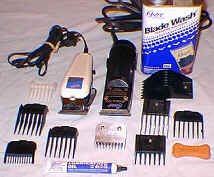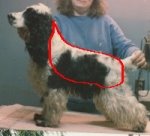
When your pet looks and smells good, he receives more attention.
BTW, keeping your pet tangle free will cut your grooming costs. Average cost of
grooming a Cocker is quoted at $30-60.
Hair clippers vary widely in cost and quality. The Wahl clippers (left) start under $20, while professional clippers, like the Oster (right), are priced at $100 and up. A wide variety of optional clipper heads are also available.
Wahl markets a number of different clipper packages. They all come with combs, which are attached to space the clipper head further out, allowing various lengths of clip. Some kits come with scissors, hair combs, and even a video on clipping your pet. For general clipping, I prefer the Wahl model MC and would recommend it for any beginner. Notice the lever on the side of the Wahl clippers (white). This slides the upper and lower blades forwards and backwards. When slid together, the clip is shorter for clipping around the eyes, when slid apart, the cut is slightly longer, for trimming the head and inside ear flaps. The longer clip helps avoid "stubble" which can cause your pet to scratch.
When buying your clippers, look around. 5 years ago, Wahl marketed their HomeCut model in one color for people, the same clipper in a different color for use on pets. Side by side at K-mart, the HomeCut was $10 cheaper, and it occasionally went on sale. In the pet stores the clippers were sometimes priced even higher. I picked up my first set for $18. With moderate to heavy use on two pets, these last about 2 years. Eventually they will begin to "growl" intermittently, which scares my dogs. I gave my first clippers away when they began showing signs of wear, and I've nearly worn out my second set.
I picked up the Oster model a couple years ago, because I do a lot of heavy clipping. I also picked up the optional "gap tooth" clipper head, about $35. In this head every other tooth is much longer. This allows a heavy coat to be sheared, while leaving enough length to avoid razor burn. The tips of the teeth are sharp very sharp, so some care must be taken when shaving around the neck "rolls". I find they do a quick, professional job. They are much heavier and the cord tends to twist the clippers in your hand. Their round shape and heaviness makes them more awkward than the Wahl.
Your clipper must be maintained properly. This includes keeping it oiled and cleaned. Allow the clipper heads to cool frequently. One mistake I made was to clip my dog's body, working down to more sensitive areas, like the feet and belly. By this time the clippers were quite warm and uncomfortable. The solution here is to split up your grooming session into several sessions, or to own more than one pair of clippers. Even though I own two sets, I like to split my sessions to avoid stressing my pets.
Between clipping pets, use a good head cleaner. This will clean out excessive buildups, and sterilize the clipper heads. Pour a little cleaner into a shallow dish and immerse the clipper heads into the cleaner, while they are running. When done, remove, clean, dry and oil your heads.
One additional item is needed to make a clipping complete, the requisite doggy bone. Most grooming shops give these out liberally, but I'm more stingy with treats. Give too many treats and they lose their special appeal. Each treat should be given with enthusiasm, so the dog knows they are something special, only given out because he was very good. Treats of cheese used to give out pills. Doggy bones are given for clippings and bathes. A vitamin or half a bone might be given out for sitting well while ear medicine is applied. Your pet will be as happy when receiving a small bone as when receiving the larger size, and he won't gain excessive weight.
Grooming, Spaniel, Dog Grooming, Clippers



 Cockers have hairy feet, which can make foot care more difficult. If hair is kept trimmed from between the toes and between the pads, the feet will stay drier, they will track less, and have better traction on slippery floors. This will reduce the number of foot infections and make nail care much simpler.
Cockers have hairy feet, which can make foot care more difficult. If hair is kept trimmed from between the toes and between the pads, the feet will stay drier, they will track less, and have better traction on slippery floors. This will reduce the number of foot infections and make nail care much simpler.



 long coat. Regular and frequent grooming is essential to keeping the coat from matting or tangling.
long coat. Regular and frequent grooming is essential to keeping the coat from matting or tangling.








